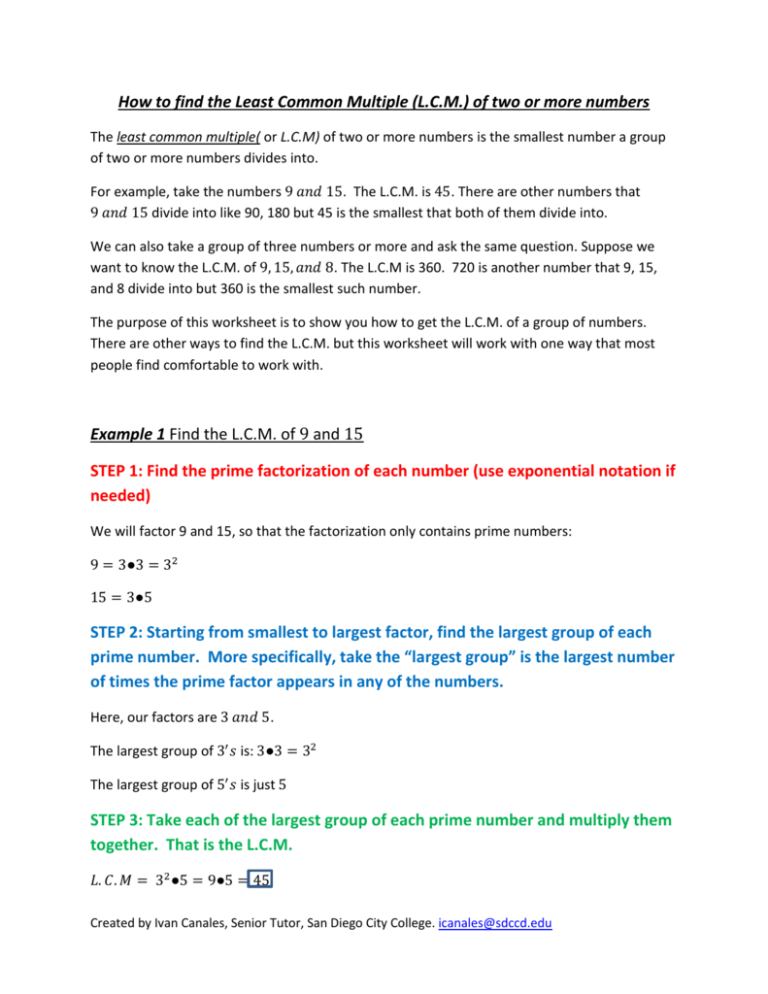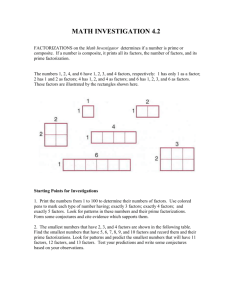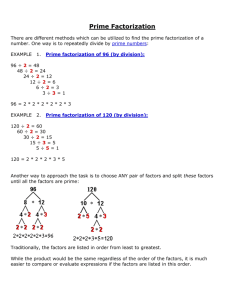How to find the Least Common Multiple
advertisement

How to find the Least Common Multiple (L.C.M.) of two or more numbers The least common multiple( or L.C.M) of two or more numbers is the smallest number a group of two or more numbers divides into. For example, take the numbers 9 𝑎𝑛𝑑 15. The L.C.M. is 45. There are other numbers that 9 𝑎𝑛𝑑 15 divide into like 90, 180 but 45 is the smallest that both of them divide into. We can also take a group of three numbers or more and ask the same question. Suppose we want to know the L.C.M. of 9, 15, 𝑎𝑛𝑑 8. The L.C.M is 360. 720 is another number that 9, 15, and 8 divide into but 360 is the smallest such number. The purpose of this worksheet is to show you how to get the L.C.M. of a group of numbers. There are other ways to find the L.C.M. but this worksheet will work with one way that most people find comfortable to work with. Example 1 Find the L.C.M. of 9 and 15 STEP 1: Find the prime factorization of each number (use exponential notation if needed) We will factor 9 and 15, so that the factorization only contains prime numbers: 9 = 3●3 = 32 15 = 3●5 STEP 2: Starting from smallest to largest factor, find the largest group of each prime number. More specifically, take the “largest group” is the largest number of times the prime factor appears in any of the numbers. Here, our factors are 3 𝑎𝑛𝑑 5. The largest group of 3′ 𝑠 is: 3●3 = 32 The largest group of 5′ 𝑠 is just 5 STEP 3: Take each of the largest group of each prime number and multiply them together. That is the L.C.M. 𝐿. 𝐶. 𝑀 = 32 ●5 = 9●5 = 45 Created by Ivan Canales, Senior Tutor, San Diego City College. icanales@sdccd.edu Example 2 Find the L.C.M. of 72 and 60 STEP 1: Find the prime factorization of each number (use exponential notation if needed) We will factor 72 and 60, so that the factorization only contains prime numbers: 72 = 9●8 = 3●3●4●2 = 3●3●2●2●2 = 32 ●23 60 = 6●10 = 2●3●2●5 = 22 ●3●5 STEP 2: Starting from smallest to largest factor, find the largest group of each prime number. More specifically, take the “largest group” is the largest number of times the prime factor appears in any of the numbers. Here, our factors are 2, 3 𝑎𝑛𝑑 5 The largest group of 2′ 𝑠 is: 2●2●2 = 23 The largest group of 3′𝑠 is: 3●3 = 32 The largest group of 5’s is just 5 STEP 3: Take each of the largest group of each prime number and multiply them together. That is the L.C.M. 𝐿. 𝐶. 𝑀 = 23 ●32 ●5 = 8●9●5 = 360 Example 3 Find the L.C.M. of 6125 and 8575 STEP 1: Find the prime factorization of each number (use exponential notation if needed) 6125 = 125●49 = 5●5●5●7●7 = 53 ●72 8575 = 25●343 = 5●5●7●7●7 = 52 ●73 STEP 2: Starting from smallest to largest factor, find the largest group of each prime number. More specifically, take the “largest group” is the largest number of times the prime factor appears in any of the numbers. Here, our factors are 5 𝑎𝑛𝑑 7. Created by Ivan Canales, Senior Tutor, San Diego City College. icanales@sdccd.edu The largest group of 5’s is: 5●5●5 = 53 The largest group of 7’s is: 7●7●7 = 73 STEP 3: Take each of the largest group of each prime number and multiply them together. That is the L.C.M. 𝐿. 𝐶. 𝑀 = 53 ●73 = 125●343 = 42875 Now, we will find the L.C.M. of three numbers Example 4 Find the L.C.M. of 18, 8, 𝑎𝑛𝑑 24 STEP 1: Find the prime factorization of each number (use exponential notation if needed) 18 = 2●9 = 2●3●3 = 2●32 8 = 2●4 = 2●2●2 = 23 24 = 4●6 = 2●2●3●2 = 23 ●3 STEP 2: Starting from smallest to largest factor, find the largest group of each prime number. More specifically, take the “largest group” is the largest number of times the prime factor appears in any of the numbers. Here our factors are 2 and 3 The largest group of 2’s is: 2●2●2 = 23 The largest group of 3’s is: 3●3●3 = 33 STEP 3: Take each of the largest group of each prime number and multiply them together. That is the L.C.M. 𝐿. 𝐶. 𝑀 = 23 ●33 = 8●9 = 72 Created by Ivan Canales, Senior Tutor, San Diego City College. icanales@sdccd.edu







